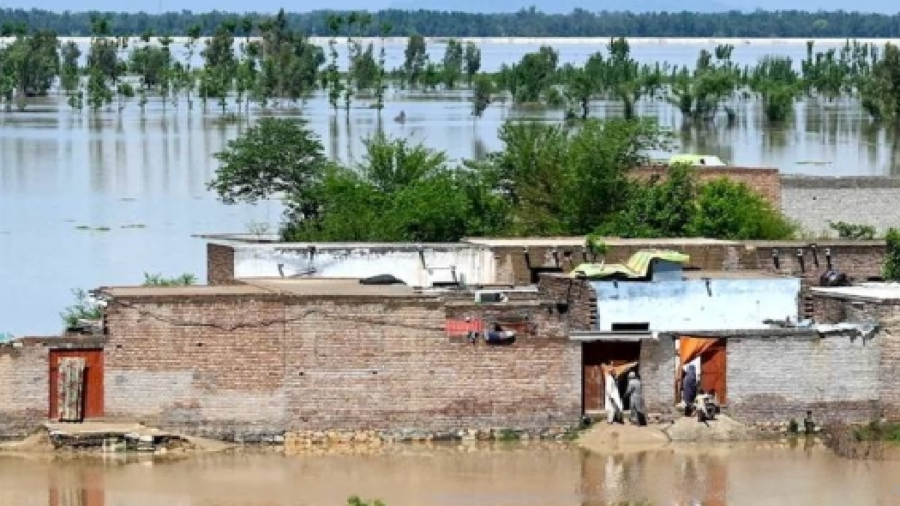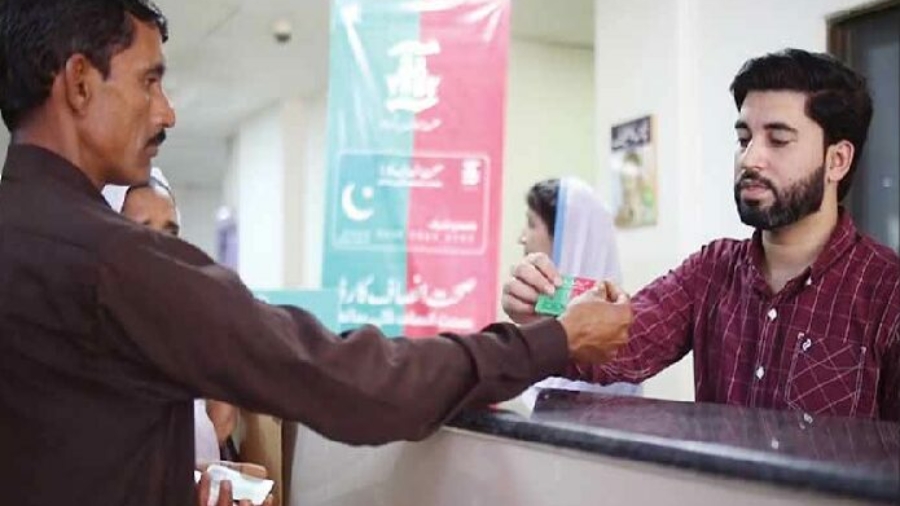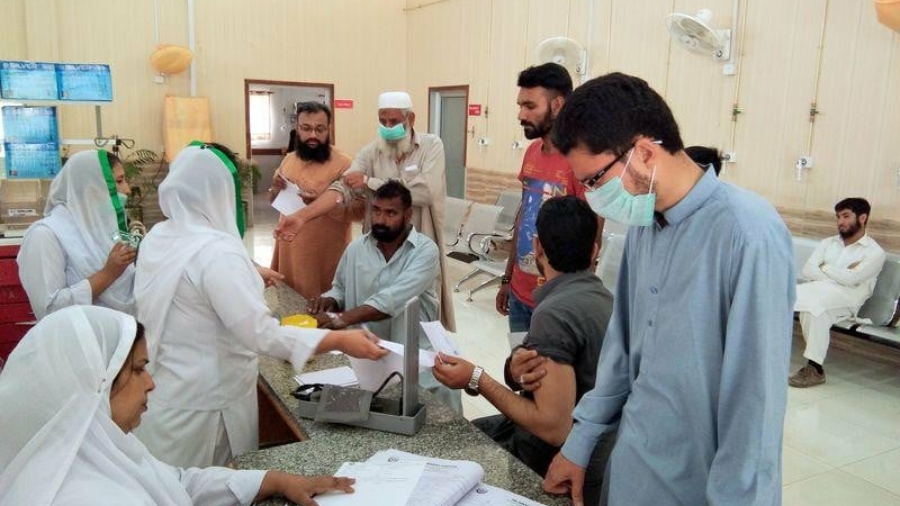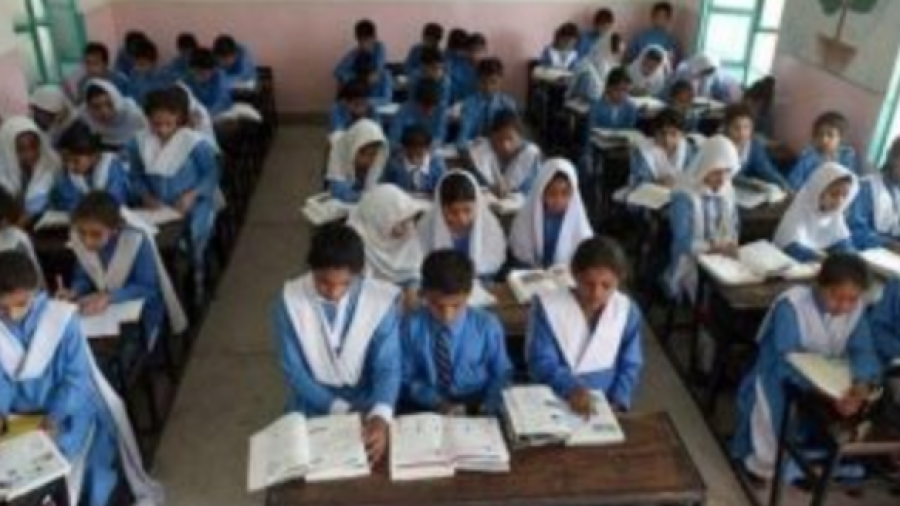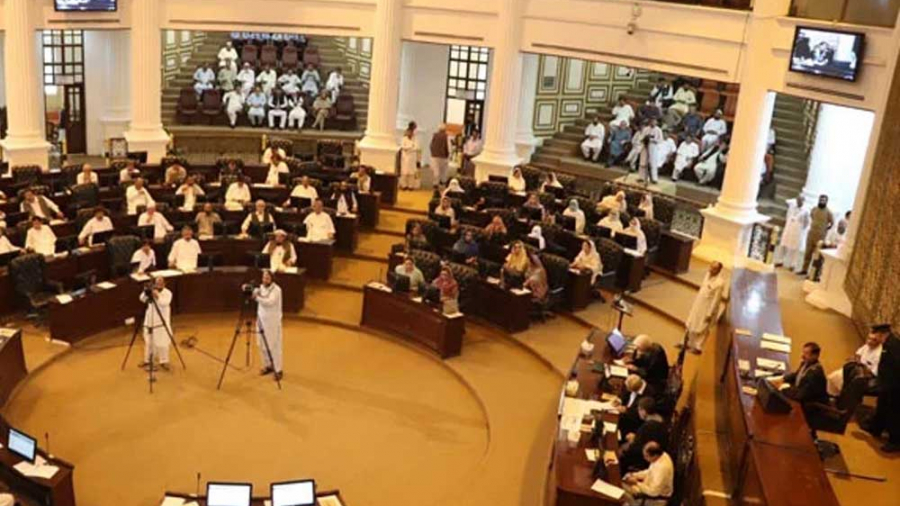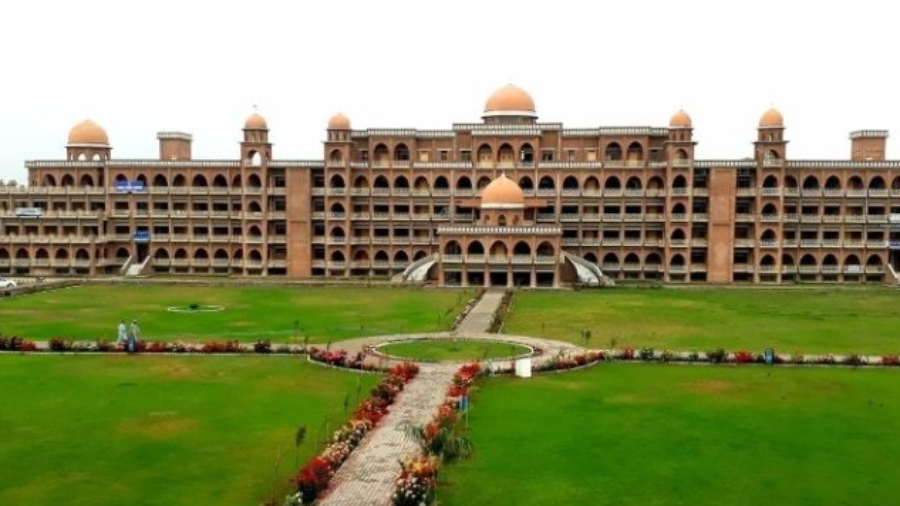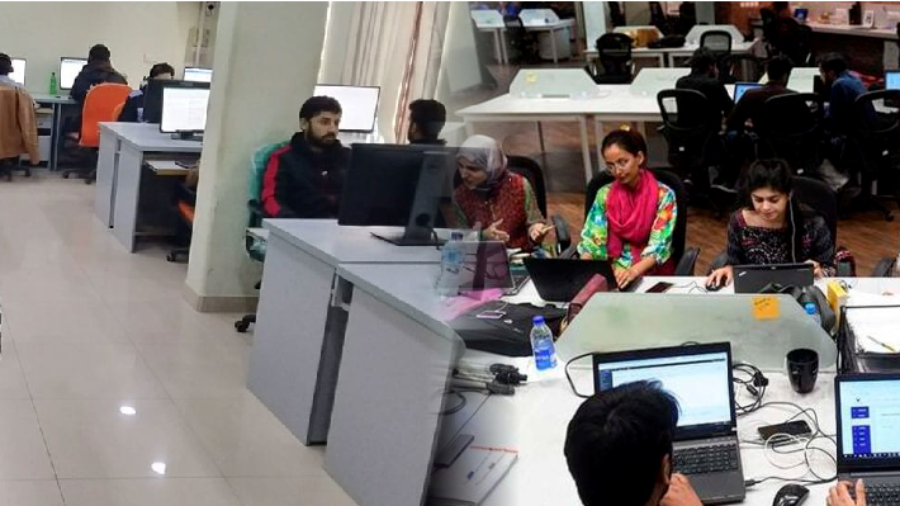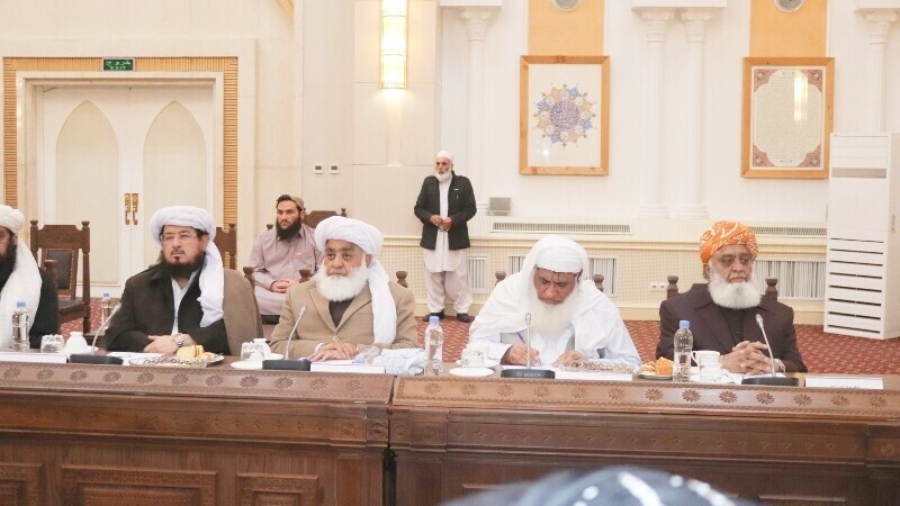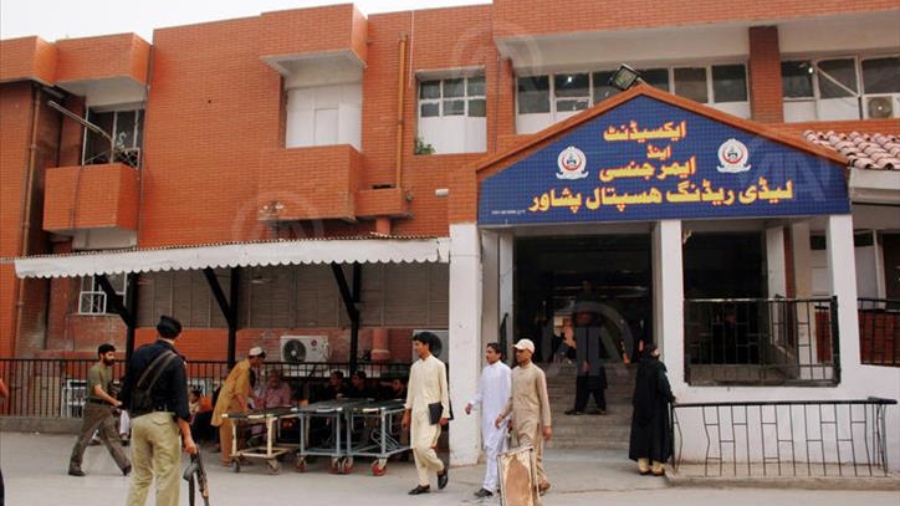As summer gets started in Khyber Pakhtunkhwa (KP) this year, the region experienced unexpected and severe weather events, including torrential rains and hailstorms in March and April. These events caused significant damage, killing 73 people and affecting crops, houses, and infrastructure. This devastation echoed the catastrophic floods of 2022, highlighting the urgent need for climate change preparedness in the region.
The KP Provincial Disaster Management Authority (PDMA) reported that the recent rains injured 92 people and damaged 3,258 houses, with 482 completely destroyed and 2,776 partially damaged. Crops on 44,320 acres, including 35,948 acres of wheat, were destroyed. Such extensive damage underscores the vulnerability of KP’s infrastructure to extreme weather. Strengthening roads, bridges, and buildings to withstand such events is crucial.
Effective early warning systems are also essential. Advanced meteorological equipment and technologies, combined with timely dissemination of weather warnings, can save lives and reduce property damage. Improved data collection and analysis will enhance the accuracy of weather predictions, allowing communities to prepare adequately for impending storms or floods.
Community involvement is critical for preparedness to cope with climate change. Local knowledge and practices can complement scientific approaches to create robust adaptation strategies. Programs that educate communities about climate risks and adaptive practices can empower individuals to take proactive measures. For instance, training farmers in water conservation techniques, crop diversification, and soil management can help mitigate the impact of erratic weather patterns on agriculture.
Establishing community-based disaster response teams can ensure a swift and organized reaction to emergencies. These teams, equipped with basic first aid, rescue skills, and communication tools, can provide immediate support during disasters, bridging the gap until official help arrives.
Agriculture, a vital sector in KP, faces severe threats from climate change. Implementing sustainable farming practices is essential to enhance resilience. The introduction of drought-resistant crop varieties, efficient irrigation systems, and organic farming methods can reduce dependency on vulnerable crop types and improve yield stability.
Adam Khan recounted his loss as floods ravaged his wheat crops. Adam Khan had previously suffered in the 2022 floods and now faced devastation again within three years. “What will I do?” he asked, expressing deep concern over how he and other farmers would meet their families’ needs amid rising inflation and repeated crop losses.
Moreover, agroforestry—integrating trees and shrubs into agricultural landscapes—can provide multiple benefits. Trees act as windbreaks, reduce soil erosion, and enhance water retention, creating a more stable environment for crops. Additionally, trees can sequester carbon, contributing to climate mitigation efforts.
Effective policy frameworks and governance are fundamental to climate preparedness. The KP government must prioritize climate action in its development agenda, ensuring that policies are inclusive and address the needs of the most vulnerable populations. This includes providing financial support to farmers and small businesses affected by climate events, as well as investing in research and development for climate-resilient technologies.
The establishment of a dedicated climate change department within the provincial government can streamline efforts and ensure that climate considerations are integrated across all sectors. This department can coordinate with national and international bodies to access funding, technical assistance, and best practices.
Healthy ecosystems play a crucial role in mitigating the impacts of climate change. Wetlands, forests, and riverbanks act as natural buffers, absorbing excess rainfall and reducing the risk of floods. Protecting and restoring these ecosystems can enhance their ability to regulate water flow and maintain biodiversity.
Afforestation and reforestation initiatives should be promoted, focusing on native species that are well-adapted to the local climate. These efforts can also provide economic benefits, such as creating jobs in tree planting and maintenance, and generating income through sustainable forest products.
Social resilience is equally important in climate preparedness. Strengthening social networks and fostering a sense of community can enhance collective response to climate events. Programs that promote social cohesion, such as community gardening projects, local markets, and social gatherings, can build trust and cooperation among residents.
Providing access to healthcare, education, and social services ensures that communities are better equipped to handle the stresses associated with climate change. Special attention should be given to vulnerable groups, including women, children, the elderly, and people with disabilities, to ensure their needs are met during and after climate events.
Climate change is a global issue, and international collaboration is vital for effective preparedness. KP can benefit from partnerships with international organizations, donor agencies, and other countries facing similar challenges. These collaborations can provide access to funding, advanced technologies, and best practices in climate adaptation and mitigation.
The Green Climate Fund and other international financial mechanisms offer resources that can support large-scale climate resilience projects in KP. By leveraging these funds, the provincial government can implement comprehensive strategies to protect its people and economy from future climate-related disasters.
Khyber Pakhtunkhwa’s experiences with extreme weather events highlight the urgent need for robust climate change preparedness. Strengthening infrastructure, enhancing early warning systems, promoting sustainable agriculture, and implementing effective policies are critical steps toward building resilience. Community involvement and ecosystem conservation play significant roles in mitigating climate impacts, while international collaboration and funding can provide the necessary support for large-scale initiatives.
As KP moves forward, a proactive and integrated approach to climate change preparedness will be essential to safeguard the region’s future. By embracing adaptive strategies and fostering resilience, KP can better withstand the challenges posed by a changing climate and protect its communities, livelihoods, and natural resources.
Challenges and Successes of KP’s Sihat Sahulat Program
Sihat Sahulat Program or Sihat Card Program is a health insurance scheme launched by the Khyber Pakhtunkhwa government to provide free healthcare services to the people. The program allows eligible families to access a range of medical services free of charge or at subsidized rates. The initiative aims to alleviate the financial burden of healthcare expenses on low-income households and enhance their access to quality healthcare services. Launched in 2016 with the promise of enhancing healthcare accessibility and affordability, the initiative has garnered attention and scrutiny alike.
Before the inception of the Sihat Card initiative, public hospitals in KP faced numerous challenges, including limited resources, infrastructure deficiencies, and overcrowding. Patients often encountered long waiting times and substandard facilities, which undermined the quality of care. However, with the introduction of the Sihat Card, there has been a noticeable improvement in the availability of resources and services in public hospitals. The initiative has infused funds into the healthcare system, enabling hospitals to upgrade infrastructure, procure essential medical equipment, and enhance service delivery. Additionally, specialized services such as cardiac care, oncology, and neonatal care have been expanded in select public hospitals, reducing the need for patients to seek treatment in private facilities.
Despite the improvements in public healthcare facilities, many beneficiaries of the Sihat Card still opt for treatment in private hospitals. Several factors contribute to this phenomenon, including perceptions of superior quality of care, shorter waiting times, and a broader range of specialized services offered by private healthcare providers. Private hospitals stand tall with shining glass panels, silver elevators, and LED monitors in the waiting areas and wards. Moreover, a Sehat Card representative is present to guide them through their journey at the hospital. Additionally, the convenience of proximity to private hospitals and the perception of better patient-provider communication also influences patients’ decisions to seek care outside the public sector. However, it is essential to note that the Sihat Card covers a significant portion of the expenses incurred at private hospitals, making them financially accessible to cardholders.
The Sihat Card initiative has significant financial implications for both the government and the beneficiaries. The government allocates substantial funds to finance the program, covering the cost of insurance premiums and reimbursing healthcare providers for services rendered to Sihat Card holders. According to government reports, the program has benefited over 6 million families in KP, including vulnerable populations such as widows, orphans, and persons with disabilities. Furthermore, the initiative has contributed to poverty alleviation by reducing out-of-pocket healthcare expenses for low-income households. Sehat Sahulat Program is indeed a novel scheme launched in good faith, but it is a big challenge to maintain patient satisfaction in the face of increasing expenses for the government. Currently, it takes at least 3 months for bills to get approved. This translates to the reality that hospitals and concerned staff keep waiting to get their share of the compensation for many months. Moreover, the surgeon generally gets a very humble (16%) share out of the package adjusted by the program.
As coverage of the Sehat Insaf card grows, the government will face another dilemma of payments pending to hospitals and doctors, as observed previously. In April 2023, State Life Insurance Corporation (SLIC) ceased accepting new admissions for the free treatment of patients under the Sehat Card Plus program due to the provincial government’s failure to settle its outstanding dues.
One of the critical aspects of the Sihat Card initiative is the quality of healthcare services provided under the program. While the initiative has undoubtedly expanded access to healthcare services, questions of care. Concerns have been raised over the adequacy of infrastructure and medical equipment in some public hospitals, and the qualifications and competence of healthcare professionals. Moreover, concerns are raised about whether the treatments, medications, and investigations provided under the program meet global standards of quality and efficacy. Continuous monitoring and evaluation mechanisms are essential to ensure that the services provided under the Sihat Card meet established standards of care and address the evolving healthcare needs of the population.
In conclusion, the Sihat Card initiative represents a commendable effort to improve healthcare access and affordability in KP, Pakistan. However, its success hinges on addressing the underlying challenges faced by the healthcare system, including the quality of services, resource allocation, and equitable distribution of healthcare facilities. Moving forward, a concerted effort is needed to ensure that the initiative delivers on its promise of providing quality healthcare services to all beneficiaries, thereby contributing to the overall health and well-being of the population.
ADDRESSING FINANCIAL WOES IN KHYBER PAKHTUNKHWA MEDICAL TEACHING INSTITUTIONS
In the heart of Khyber Pakhtunkhwa, medical teaching institutions (MTIs) stand as pillars of healthcare, providing vital services to communities in need. Yet, behind their noble mission lies a tale of financial distress, as MTIs grapple with drug shortages and delayed salary payments, casting a shadow over their ability to fulfill their crucial role.
The saga of financial turmoil began with the change in government last year, leaving MTIs stranded without the necessary funding to sustain their operations. The promise of autonomy under the Medical Teaching Institutions Reforms Act (MTIRA) once held hope for these institutions, empowering them to make independent decisions and break free from bureaucratic constraints. However, the reality paints a starkly different picture, with MTIs now struggling to make ends meet.
In the corridors of these institutions, tales of desperation emerge from accident and emergency departments, where shortages of life-saving drugs exacerbate the plight of those in critical need. It’s a dire situation, one that demands urgent attention and decisive action.
Hope flickers on the horizon as officials express optimism for the future under the newly-elected government. With the Pakistan Tehreek-i-Insaf (PTI) at the helm once again, there’s a renewed sense of anticipation that financial woes will be addressed, and MTIs will receive the support they desperately need.
The Rising Stars: How youth from tribal districts are shining bright
The Rising Stars: How youth from tribal districts are shining bright
In the rugged terrain of the newly merged districts of Khyber Pakhtunkhwa, where education was once scarce and opportunities limited, a remarkable transformation is underway. Once considered remote and underdeveloped, these areas are now witnessing the emergence of a new generation of talented and resilient youth who are making waves in various fields, from sports to politics, and beyond.
The remarkable rise of these young talents from the tribal districts not only reflects the region’s newfound stability and peace but also underscores the importance of investing in education and opportunities for the youth. As they continue to shine and make their country proud on various platforms, they serve as role models for future generations, embodying the spirit of resilience, determination, and excellence. The youth from the tribal districts are indeed the rising stars of Pakistan, illuminating the path towards a brighter and more inclusive future for all.
The journey of the youth from the tribal districts towards success and recognition has not been without its challenges. For decades, these areas were marred by instability, conflict, and a lack of infrastructure, which severely limited access to education and opportunities for the younger generation. The region’s tribal culture and conservative norms further compounded these challenges, particularly for women, who often faced additional barriers to pursuing their dreams and aspirations.
However, despite these daunting odds, the youth of the tribal districts refused to be deterred. With resilience, determination, and a relentless pursuit of excellence, they began to carve out their paths towards success, defying stereotypes and breaking down barriers along the way.
One of the most prominent examples of this indomitable spirit is seen in the realm of sports, particularly cricket. Historically, the tribal districts were not known for producing cricketing talent on a national or international level. However, in recent years, a wave of young cricketers has emerged from these areas, captivating audiences with their raw talent and skill.
Shaheen Shah Afridi, hailing from the Khyber district, is one such rising star. Known for his lethal pace and ability to swing the ball, Shaheen has quickly risen through the ranks to become one of Pakistan’s most promising fast bowlers. With his impressive performances on the field, he has not only earned the admiration of fans but has also become a symbol of hope and inspiration for aspiring cricketers from the tribal regions.
Similarly, Abbas Khan Afridi, another talented cricketer from the Khyber district, has been making waves in the world of cricket with his consistent performances and all-round skills. With each match, Abbas continues to prove that talent knows no boundaries and that with dedication and hard work, anything is possible.
But cricket is not the only arena where the youth from the tribal districts are making their mark. In the field of squash, Maria Toorpakai’s journey from the tribal regions of Pakistan to becoming the country’s top-ranked female player is nothing short of extraordinary. Despite facing numerous obstacles and threats, Maria refused to let fear dictate her path. Through sheer determination and unwavering courage, she pursued her passion for squash, eventually rising to prominence on the international stage.
Maria’s story serves as a powerful reminder of the resilience and strength of the youth from the tribal districts, who continue to defy the odds and chase their dreams against all odds. Her achievements have not only brought glory to Pakistan but have also inspired countless others to break free from the shackles of fear and doubt and pursue their passions with conviction.
In addition to sports, the youth from the tribal districts are also making their presence felt in the realm of politics. Ayesha Gulalai and Zartaj Gul Wazir, both born and raised in the tribal regions, have risen to prominence as dynamic and influential political leaders. Their journey from the tribal districts to the hallowed halls of the National Assembly is a testament to their resilience, determination, and commitment to bringing about positive change in their communities.
Through their leadership and advocacy, Ayesha and Zartaj have become powerful voices for the marginalized and disenfranchised, challenging the status quo and advocating for the rights and interests of their constituents. Their success in the political arena has not only shattered stereotypes but has also paved the way for other young leaders from the tribal districts to step forward and make their voices heard.
Indeed, the youth from the tribal districts are the future of Pakistan, and their rise to prominence serves as a beacon of hope and inspiration for the entire nation. Despite the myriad challenges they face, they continue to defy expectations and break down barriers, proving that with resilience, determination, and unwavering faith, anything is possible.
As the tribal districts continue on their journey towards peace, stability, and prosperity, it is imperative that the government and other stakeholders continue to invest in the education, training, and development of the region’s youth. By providing them with the tools, resources, and opportunities they need to succeed, we can ensure that the youth from the tribal districts continue to shine bright and make their country proud for generations to come.
Hope Amidst Challenges
Addressing Financial Woes in Khyber Pakhtunkhwa Medical Teaching Institutions: Hope Amidst Challenges
In the heart of Khyber Pakhtunkhwa, medical teaching institutions (MTIs) stand as pillars of healthcare, providing vital services to communities in need. Yet, behind their noble mission lies a tale of financial distress, as MTIs grapple with drug shortages and delayed salary payments, casting a shadow over their ability to fulfill their crucial role.
The saga of financial turmoil began with the change in government last year, leaving MTIs stranded without the necessary funding to sustain their operations. The promise of autonomy under the Medical Teaching Institutions Reforms Act (MTIRA) once held hope for these institutions, empowering them to make independent decisions and break free from bureaucratic constraints. However, the reality paints a starkly different picture, with MTIs now struggling to make ends meet.
From Peshawar to beyond, voices from within MTIs echo concerns of delayed salaries and dwindling medical supplies. For employees, the frustration of receiving salaries weeks after their due date adds insult to injury, while patients bear the brunt of drug shortages, forced to seek essential medicines from external sources.
In the corridors of these institutions, tales of desperation emerge from accident and emergency departments, where shortages of life-saving drugs exacerbate the plight of those in critical need. It’s a dire situation, one that demands urgent attention and decisive action.
Hope flickers on the horizon as officials express optimism for the future under the newly-elected government. With the Pakistan Tehreek-i-Insaf (PTI) at the helm once again, there’s a renewed sense of anticipation that financial woes will be addressed, and MTIs will receive the support they desperately need. Memories of smoother cash flows and timely funds under previous PTI regimes fuel this optimism, signaling a potential turning point for these beleaguered institutions.
Yet, challenges persist, as political maneuvers and bureaucratic hurdles threaten to derail progress. The attempts by caretaker administrations to dismantle MTIRA and replace appointed boards of governors serve as reminders of the precarious landscape in which MTIs operate. But amidst the uncertainty, resilience prevails, with stakeholders clinging to the hope that elected leadership will usher in stability and prosperity.
As medical specialists contemplate their future amidst the turmoil, the fate of MTIs hangs in the balance. The appointment of a new health minister holds the promise of much-needed relief, offering a glimmer of hope to those who tirelessly serve on the frontlines of healthcare.
In the corridors of power, decisions will be made that shape the destiny of MTIs and the communities they serve. It’s a pivotal moment, where the voices of the marginalized and the needs of the vulnerable must not be drowned out by political rhetoric or bureaucratic inertia.
The road ahead may be fraught with challenges, but it’s also paved with opportunity. With concerted efforts and unwavering commitment, we can overcome the financial hurdles that threaten to undermine the noble mission of MTIs. Together, let us strive to ensure that every individual has access to quality healthcare, and that the promise of MTIRA becomes a reality for all.
As we navigate the complexities of governance and healthcare delivery, let us not lose sight of the human element at the heart of this struggle. Behind every statistic and budgetary allocation lies a life in need of care and compassion. It’s this human element that must guide our actions and inspire us to forge ahead, despite the obstacles that lie ahead.
In the end, the true measure of our success will not be found in balance sheets or policy documents, but in the lives we touch and the communities we uplift. Let us seize this moment as an opportunity to reaffirm our commitment to the principles of equity, justice, and compassion that lie at the core of our healthcare system. Together, we can overcome the challenges that stand in our way and build a future where every individual has access to the care they need and deserve.
Educating for Tomorrow: KP’s Battle for Better Education
Over the past two decades, Khyber Pakhtunkhwa (KP) has navigated a tumultuous path in its educational landscape. Political instability, economic challenges, and ineffective governance have cast a shadow over the region’s educational prospects. This decline in standards has led to a significant increase in dropout rates among students, exacerbating the already prevalent issue of illiteracy.
The repercussions of this decline are stark, with over 4.7 million children out of school in KP according to the Benazir Income Support Program (BISP) 2021 survey. The situation is particularly dire for girls and children from merged tribal districts, perpetuating cycles of poverty and impeding progress.
Various districts, including Palas Kolai, Upper Kohistan, Torghar, and Lakki Marwat, stand at the forefront of this educational crisis. Despite past efforts, the failure to implement effective education policies has left these areas grappling with high percentages of out-of-school children. The merged tribal areas, such as North Waziristan and Bajaur, face similar challenges, emphasizing the urgent need for intervention.
Individual stories, like that of Hina from Sawabi, shed light on the harsh realities faced by many families. Economic hardships often force children out of school and into the workforce prematurely, perpetuating the cycle of poverty and illiteracy.
In response to these challenges, the KP Education Department has formulated comprehensive strategies. These include the establishment of new schools, the implementation of alternate learning pathways (ALP), and a focus on Early Child Education (ECE) policies. Additionally, initiatives such as teacher training programs, literacy centers, and scholarship disbursements aim to enhance educational access and quality.
The government’s commitment to modernizing education infrastructure is evident through initiatives like transitioning schools to solar energy and investing in digital skills training. Plans to provide free textbooks and explore digital learning platforms underscore a commitment to inclusive and accessible education for all.
However, despite these efforts, hurdles remain on the path to reform. The government must prioritize education, allocate sufficient resources, and ensure effective implementation to overcome entrenched barriers. Collaboration between government bodies, NGOs, and communities is crucial in driving sustainable change.
In recent years, there have been promising developments in KP’s education sector. The government’s efforts have resulted in the establishment of numerous schools and the provision of educational resources to underserved areas. Additionally, initiatives such as the Merit and Need-Based Scholarship Program have enabled deserving students to pursue higher education, breaking the cycle of poverty.
Moreover, community engagement programs have empowered local stakeholders to play an active role in improving educational outcomes. Through initiatives like parent-teacher associations and community-led education projects, KP is fostering a culture of ownership and accountability in its education sector.
Despite these positive strides, significant challenges persist. Infrastructure gaps, teacher shortages, and cultural barriers continue to hinder progress. Furthermore, the COVID-19 pandemic has exacerbated existing inequalities, disproportionately affecting marginalized communities and widening the education gap.
To address these challenges, sustained investment and innovative approaches are needed. Leveraging technology, enhancing teacher training programs, and strengthening partnerships with the private sector can help KP build a resilient and inclusive education system.
In conclusion, while KP’s journey towards educational reform may be fraught with challenges, it is also marked by resilience and determination. By prioritizing education and fostering collaboration, KP can unlock its potential and pave the way for a brighter future. Through concerted efforts and unwavering commitment, KP can ensure that every child has access to quality education, empowering them to realize their full potential and contribute to the region’s prosperity.
Political Earthquake in Khyber Pakhtunkhwa: Disillusionment Strikes Major Parties
The General Election of 2024 in Khyber Pakhtunkhwa (KP) left numerous political analysts and party supporters perplexed, as they witnessed a seismic shift in the electoral in the electoral landscape. Major political parties experienced unexpected defeats in their traditional strongholds. Notably, parties such as the Awami National Party (ANP), Jamaat-e-Islami (JI), Jamiat Ulema-e-Islam-Fazal (JUI-F), Qaumi Watan Party (QWP), Pakistan Muslim League-Nawaz (PML-N), and Pakistan People’s Party (PPP) are among those forced to reevaluate their strategies and positions.
The defeat of JUI-F Chief Maulana Fazlur Rehman in his home constituency (NA-44) of Dera Ismail Khan, for the second consecutive time, epitomizes the startling turn of events. The decline in JUI-F’s representation from 12 to merely six seats in the provincial assembly underscores the party’s unexpected setback. Similarly, ANP, once a formidable force, faced defeats in key constituencies, with even stalwarts like Amir Haidar Khan Hoti, Ghulam Bilour and Aimal Wali Khan failing to secure victory.
Jamaat-e-Islami, known for its strongholds in parts of Malakand division, suffered a significant blow with defeats in Dir Lower and Dir Upper, areas previously considered its bastions. The party’s inability to maintain its grip on these territories signifies a paradigm shift in voter sentiment. Qaumi Watan Party, led by Aftab Ahmad Khan Sherpao, failed to secure a single seat in both national and provincial assemblies for the second time, reflecting a stark decline from its previous electoral performance.
The Pakistan People’s Party Parliamentarian, though managing to secure a few provincial and national assembly seats, experienced setbacks, including the loss of key figures like Muhammad Ali Shah Bacha. Despite marginal improvements in some areas, the overall outcome suggests a challenging road ahead for the party in KP.
The defeat of former Prime Minister Nawaz Sharif in NA-15 Mansehra-cum-Torghar to a PTI-backed candidate further underscores the shifting dynamics, even in regions traditionally loyal to PML-N. This unexpected loss has sent shockwaves through the party ranks, highlighting the need for introspection and strategic reassessment.
The implications of these electoral upsets extend beyond mere numerical losses; they represent a broader disillusionment among voters and a demand for change. The electorate’s rejection of entrenched political players signals a desire for fresh leadership and a departure from traditional power structures. As major parties convene emergency meetings to dissect the election results, one thing remains clear: the political landscape of Khyber Pakhtunkhwa has undergone a seismic transformation, ushering in a new era of uncertainty and recalibration for all stakeholders involved.
The disheartening defeats suffered by prominent political figures like Maulana Fazlur Rehman and Nawaz Sharif underscore the unpredictable nature of contemporary politics. Despite their extensive political experience and deep-rooted connections, these leaders found themselves at odds with an electorate craving change and renewal. The PTI’s ability to capitalize on this sentiment, particularly in regions like Khyber Pakhtunkhwa, highlights the party’s evolving political acumen and organizational strength.
Moreover, the electoral setbacks faced by ANP, JI, QWP, and others raise questions about their relevance and appeal in the current political landscape. Traditional markers of political loyalty and identity appear to be eroding, replaced by a more fluid and dynamic electorate driven by pragmatic considerations and shifting allegiances. This trend signals a fundamental recalibration of power dynamics within Khyber Pakhtunkhwa and underscores the need for political actors to adapt to evolving realities.
In the wake of these electoral upsets, the affected parties must engage in sincere introspection and soul-searching to understand the root causes of their defeat. Whether it be a failure to connect with voters, internal rifts and disunity, or a lack of compelling vision and leadership, these parties must address their shortcomings head-on if they hope to regain relevance and rebuild trust with the electorate.
Furthermore, the 2024 general election serves as a stark reminder of the inherent volatility of politics and the unpredictability of electoral outcomes. No party can afford to rest on its laurels or take its traditional support base for granted. The electorate’s mood can shift swiftly, propelled by a myriad of factors ranging from economic concerns to social dynamics and geopolitical developments. As such, political parties must remain vigilant, adaptive, and responsive to the ever-changing needs and aspirations of the electorate.
In conclusion, the results of the General Election 2024 in Khyber Pakhtunkhwa represent a watershed moment in the region’s political history. The unexpected defeats suffered by major political parties signal a seismic shift in the electoral landscape, characterized by disillusionment, disaffection, and a demand for change. As the dust settles and parties grapple with the aftermath of their electoral setbacks, one thing remains clear: the era of complacency and entitlement is over, replaced by a new era of uncertainty, dynamism, and opportunity.
Crisis Unfolding: The Decline in Student Enrollments Grips KP’s Premier University
Crisis Unfolding: The Decline in Student Enrollments Grips Khyber Pakhtunkhwa’s Premier University
In a disconcerting development, the University of Peshawar, the largest academic institution in Khyber Pakhtunkhwa (KP), finds itself in the throes of a significant decline in student enrollments for its Bachelor of Science (BS) programs. This unsettling trend not only raises questions about the financial health of the university but also sheds light on broader challenges facing higher education in the region.
According to recent reports, the University of Peshawar, with a capacity to admit 6,000 students annually across its 53 departments, has experienced a staggering 50% drop in admissions this year. The enrollment figures for BS programs have dwindled to just over 2,800 students, a stark contrast to the numbers from the preceding academic year.
The repercussions of this decline extend beyond mere statistics. A closer examination reveals that 10 out of the 53 departments have not admitted a single student. Disciplines such as Pashto, Persian, Philosophy, Gender Studies, History, and Social Work find themselves grappling with the prospect of empty classrooms. The financial fallout is projected to be substantial, with an estimated annual loss of 18 crore rupees, exacerbating the university’s existing financial challenges.
Education experts identify a confluence of factors contributing to this concerning downturn. Chief among them is a notable increase in fees, rising by several percentage points. The fee per semester for BS programs has surged from 52 thousand to 72 thousand rupees, potentially acting as a deterrent for aspiring students, especially in a region where financial constraints are prevalent.
A crucial observation is the emergence of BS programs in most provincial colleges, offering a fixed fee of 4,500 rupees per semester. This affordability factor in regional colleges could be drawing students away from the university, opting for more economical educational alternatives.
The situation at the University of Peshawar is not an isolated incident but reflective of challenges faced by other universities in Khyber Pakhtunkhwa. The landscape of higher education in the province is evolving, with new institutions vying for student attention. This shift presents both opportunities and threats, as established universities must adapt to remain attractive and relevant.
As the premier educational institution grapples with these challenges, it becomes imperative to assess the broader implications for higher education in Khyber Pakhtunkhwa. The declining enrollments not only pose a threat to the academic vibrancy of individual universities but also raise concerns about the overall quality and accessibility of higher education in the region.
The stakes are high, and the response to this crisis will shape the future trajectory of universities in Khyber Pakhtunkhwa. It necessitates a strategic reevaluation of fee structures, a focus on enhancing the competitive edge of established institutions, and a proactive approach to address the evolving needs and preferences of students in a rapidly changing educational landscape.
The resilience and adaptability of universities in KP will play a pivotal role in determining their future relevance and sustainability. While the current scenario presents formidable challenges, it also offers an opportunity for higher education institutions to introspect, innovate, and emerge stronger to meet the educational needs of the diverse and dynamic student population in Khyber Pakhtunkhwa. As these universities navigate the evolving landscape, their ability to innovate and adapt will be crucial in ensuring the continued vibrancy and relevance of higher education in the region.
To comprehend the depth of the issue, it is essential to explore the challenges faced by other universities in Khyber Pakhtunkhwa. The University of Peshawar’s predicament is not an isolated occurrence but a symptom of a broader ailment afflicting the higher education sector in the province.
Reports indicate that several universities in KP are witnessing a notable decrease in student admissions, presenting a collective challenge to the region’s higher education landscape. A key contributing factor to this decline is the surge in tuition fees across various institutions. The financial strain imposed on students, combined with economic uncertainties in the region, is discouraging prospective applicants from pursuing higher education.
Moreover, the proliferation of universities in different districts of KP has reshaped the higher education landscape. The allure of proximity and accessibility offered by these newer institutions has resulted in a redistribution of student preferences. Established universities are grappling with heightened competition, compelling them to reassess their strategies to attract and retain students.
Furthermore, the introduction of BS programs in provincial colleges, featuring significantly lower tuition fees, has emerged as a formidable competitor to traditional universities. The fixed fee of 4,500 rupees per semester in these colleges has made education more accessible for many students, diverting them from the more expensive university options.
Departments in various universities are feeling the impact of this enrollment crisis. Disciplines such as Pashto, Persian, Philosophy, Gender Studies, History, and Social Work, which have historically been integral components of a well-rounded education, are particularly vulnerable. Several departments are reporting a complete absence of new admissions, posing a threat to the continuity and vitality of these academic fields.
The financial implications of declining enrollments are not confined to individual universities but extend to the overall health of the higher education sector in KP. The annual loss of millions of rupees for each affected institution exacerbates financial deficits, limiting their capacity to provide quality education and invest in essential infrastructure and faculty development.
As the educational landscape in KP undergoes a transformation, it becomes imperative for universities to adapt and innovate. Strategic measures such as revisiting fee structures, enhancing the relevance of academic programs, and investing in marketing and outreach efforts are crucial for these institutions to navigate the challenges posed by the evolving preferences of students.
The resilience and adaptability of universities in KP will play a pivotal role in determining their future relevance and sustainability. While the current scenario presents formidable challenges, it also offers an opportunity for higher education institutions to introspect, innovate, and emerge stronger to meet the educational needs of the diverse and dynamic student population in Khyber Pakhtunkhwa. As these universities navigate the evolving landscape, their ability to innovate and adapt will be crucial in ensuring the continued vibrancy and relevance of higher education in the region.
Peshawar Digital Skills Centre: A Step towards Empowering the Next Generation
In a remarkable display of commitment to education and skill development, the Pakistan Army has spearheaded the establishment of a Digital Skills Centre in Peshawar, situated at Hasan Khel. This visionary initiative, operating within the premises of Government High School Shamshato, is poised to redefine education in Khyber Pakhtunkhwa (KP). Beyond the conventional realms of academia, the Digital Skills Program is laying the foundation for a more empowered and technologically adept generation.
The heart of this transformative initiative lies in providing comprehensive training to young individuals. The Digital Skills Centre, equipped with a cutting-edge computer lab, hosts a diverse range of training courses ensuring that students not only receive theoretical knowledge but also acquire hands-on practical experience. This holistic approach is cultivating a generation capable of navigating the intricacies of the digital economy and contributing meaningfully to the workforce.
One of the most commendable aspects of the program is its emphasis on empowering women through modern skills. As the Digital Skills Centre expands into its second phase, it is set to amplify its impact by enhancing the skill set of women in the region. By breaking down traditional barriers and fostering gender inclusivity, the program aligns with the broader goals of social development and equality.
The establishment of the Digital Skills Centre is a testament to the foresight and dedication of the Pakistan Army. Beyond its primary role in national defense, the Army has strategically aligned itself with the mission of nation-building. By investing in education, particularly in cutting-edge digital skills, the Army is contributing to the creation of a workforce that can compete on the global stage.
The Digital Skills Centre not only serves as a symbol of progress but also as a tangible example of the Pakistan Army’s commitment to the well-being and future prosperity of the nation. The initiative showcases the Army’s understanding of the evolving needs of society and its proactive approach to address them.
Beyond its impact on education, such Digital Skills Program will play a crucial role in economic development. By focusing on practical skills demanded by the digital era, the program is effectively contributing to the creation of a skilled workforce. This, in turn, has a ripple effect on the economic landscape of the region, as skilled individuals are better positioned to secure employment and contribute to economic growth.
Conclusion: The Pakistan Army’s establishment of the Digital Skills Center in Peshawar is a shining example of how a national institution can lead the way in shaping the future of its people. This initiative not only uplifts education in KP but also sets a precedent for other regions to follow. As we admire the Army’s foresight and commitment to holistic development, it is evident that this initiative will leave a lasting impact, creating a more empowered, skilled, and prosperous Pakistan.
Maulana Fazlur Rehman Takes the Spotlight in Pivotal Talks
In a diplomatic spectacle that has seized the attention of the international community, Maulana Fazlur Rehman, the influential leader of Jamiat Ulema-i-Islam Fazl (JUI-F), has assumed a central and critical role in high-stakes deliberations with Afghanistan’s Prime Minister Mullah Hasan Akhund. This meeting, notable as the first official visit by a JUI-F delegation to Afghanistan since the Taliban’s 2021 takeover, carries the weight of mending the strained relations between Kabul and Islamabad, unveiling the complex tapestry of geopolitics in the region.
The assurances articulated by Prime Minister Mullah Hasan Akhund during these talks, asserting Afghanistan’s lack of hostile intentions towards Pakistan or any neighboring nation, are not merely diplomatic pleasantries but strategic moves aimed at projecting an image of maturity and cooperation. By emphasizing the role of religious scholars, prominently Maulana Fazlur Rehman, in conflict resolution, Mullah Hasan seeks to construct a narrative steeped in shared values and mutual understanding—a narrative that is crucial for rebuilding trust that has eroded over the years.
However, the crux of contention arises as Mullah Hasan criticizes Pakistan’s treatment of Afghan refugees, labeling it as “brutal.” This critique not only addresses a longstanding humanitarian concern but also exposes the intricate complexities embedded in the Afghan-Pak relationship. The issue is further compounded by Pakistan’s recent deportation of nearly half a million undocumented Afghans since November 1, 2023, which has strained ties even further. Mullah Hasan’s emphasis on the mistreatment of Afghan refugees amplifies the humanitarian dimension, portraying Pakistan’s policies as not only politically insensitive but also morally questionable.
Amid these diplomatic overtures, the recent surge in terrorist attacks from cross-border, particularly those claimed by the Tehreek-i-Taliban (TTP), adds an ominous layer to the negotiations. Pakistan contends that groups like TTP exploit Afghan soil against its interests, while the Afghan Taliban denies such allegations, exposing a persistent trust deficit. The timing of a deadly attack in Khyber Pakhtunkhwa’s Bajaur district, just hours before the talks, underscores the urgency of addressing security concerns to pave the way for meaningful diplomatic progress.
Maulana Fazlur Rehman’s role in these talks cannot be overstated. As the leader of the JUI-F delegation, his acknowledgment of the Taliban’s victory against the invasion and his call for enhanced cooperation with Afghanistan underscore a nuanced approach. Striking a delicate balance between recognizing the Taliban’s achievements and advocating for improved relations with Pakistan, Maulana Fazlur Rehman positions himself as a mediator seeking a middle ground.
His condemnation of the mistreatment and forced deportation of Afghan refugees aligns with the broader sentiment within Afghanistan. By articulating his party’s stance against such practices, Maulana Fazlur Rehman not only highlights the humanitarian aspect but also positions the JUI-F as a voice for the vulnerable in the geopolitical landscape.
Yet, the critical question remains: Will these diplomatic efforts translate into tangible outcomes? The delicate balancing act of addressing security concerns, humanitarian issues, and historical grievances demands a level of cooperation that has been elusive in the past. As both Afghanistan and Pakistan grapple with complex geopolitical realities, the success of these talks hinges on whether the parties can move beyond symbolic gestures and engage in substantive dialogue.
In conclusion, Maulana Fazlur Rehman’s role in the talks between Afghanistan and Pakistan marks a significant chapter in the complex narrative of regional diplomacy. This critical analysis reveals the multifaceted nature of the challenges at hand — from security concerns to humanitarian issues — and underscores the need for a nuanced and comprehensive approach to foster lasting peace in the region. The coming weeks will reveal whether these talks serve as a catalyst for change or become yet another chapter in the protracted history of strained relations.
Unraveling the Healthcare Quagmire in KP: A Critical Analysis
Unraveling the Healthcare Quagmire in Khyber-Pakhtunkhwa: A Critical Analysis
The healthcare system in Khyber-Pakhtunkhwa is teetering on the edge of a precipice, ensnared in a quagmire of financial mismanagement, administrative apathy, and a disconcerting exodus of experienced medical professionals. Lady Reading Hospital (LRH), the linchpin of healthcare in the province, is grappling with a crisis that not only jeopardizes patient care but also exposes the systemic failures ingrained in the region’s healthcare infrastructure.
At the core of this predicament lies a severe financial crunch that has unleashed a cascade of issues. The suspension of an Rs2 billion payment under the Insaf Sehat Card category due to the government’s failure to release funds epitomizes the financial mismanagement plaguing LRH. This, coupled with outstanding payments of Rs600 million to pharmacies for essential medicines, paints a bleak picture of financial stewardship.
While recent government releases of funds have been touted as a solution, the amounts disbursed are a mere band-aid, primarily covering staff salaries. This myopic approach to financial allocation perpetuates the cycle of crisis rather than addressing the root causes. The lack of foresight in financial planning and the failure to prioritize critical healthcare needs demonstrate a systemic short-sightedness that exacerbates the existing challenges.
The departure of senior doctors, especially those with international qualifications, underscores a deeper issue – the erosion of confidence in the local healthcare system. These professionals, with years of experience and specialized skills, seek greener pastures abroad, leaving behind critical vacancies in key departments. The exodus of talents such as Dr. Tariq Sohail, the province’s only cardiac surgeon for children, and Dr. Tahir Muhammad, a cancer specialist, is a testament to the palpable disillusionment among healthcare professionals.
The impact of this brain drain reverberates through the corridors of LRH, with vital departments like the intensive care unit (ICU) and pediatric surgery left in disarray. The ensuing vacuum exacerbates the strain on the fragile healthcare system, directly impacting patient care and safety.
The approval of recruitment against vacant posts by LRH’s board of governors is a welcome move, but it reeks of a reactive approach rather than a strategic vision to address the systemic issues. Urgent hiring may fill immediate gaps, but without a comprehensive strategy to retain and attract medical talent, the cycle of departures is likely to persist.
Moreover, the reinstatement of health care services and piecemeal funding injections are akin to applying band-aids to a festering wound. Without a fundamental overhaul of financial governance, transparent budget allocations, and a commitment to addressing the root causes, these temporary measures are tantamount to kicking the can down the road.
The domino effect of late payments to doctors, the unavailability of medicines, and the overall discouragement among healthcare professionals have created an atmosphere of despondency. Patients, already grappling with health challenges, are caught in the crossfire of administrative ineptitude and systemic negligence.
The critical departments, now bereft of experienced heads, face a perilous future. Consultants in the ICU contemplating leaving their positions foreshadow a worsening situation. The healthcare crisis in Khyber-Pakhtunkhwa is not merely an administrative glitch; it is a deeply rooted malaise that demands a holistic, strategic intervention.
In dissecting the healthcare crisis in Khyber-Pakhtunkhwa, it becomes evident that the province is in the throes of a multidimensional catastrophe. Immediate measures, while essential, are insufficient without a concerted effort to address the underlying issues. The province needs a paradigm shift in its approach to healthcare governance – one that prioritizes transparency, strategic planning, and a genuine commitment to the well-being of its citizens. The current trajectory, marked by financial mismanagement and a haemorrhaging of medical expertise, is unsustainable and demands urgent, comprehensive reforms to salvage the ailing healthcare system.


